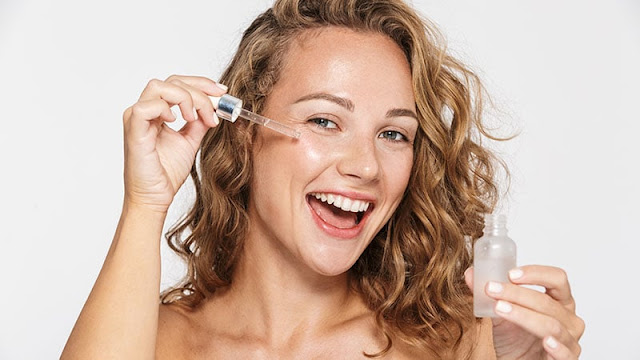If you want to level up your skincare regime with extra hydration, then look no further than hyaluronic acid (HA). This superhero ingredient is in huge demand. It pops up in various skin care products, from serums and moisturizers to tanning lotion and sheet masks. As a powerful humectant, it draws moisture to the skin for a plumped-up dewy look that also minimizes the signs of aging. Plus, it’s excellent for all skin types and is easy to use so that everyone can have youthful, glowy skin.
What is Hyaluronic Acid?
Hyaluronic acid might sound a bit scary, but it’s actually a naturally occurring sugar molecule found in the body. This powerful humectant draws water to the skin’s surface, binding it to collagen molecules for better hydration and a more dewy appearance. Your body’s natural stuff can hold a thousand times its weight in water and is produced with cellular turnover. You can increase the amount your body makes through chemical exfoliation and daily gua sha massage. A diet rich in leafy greens, root vegetables, citrus, soy-based foods, and bone broth can also boost your natural levels. Meanwhile, the hyaluronic acid found in serums and moisturizer is often lab-grown and can be produced in different molecular weights for varying levels of skin penetration. It’s an excellent supplement to your natural stores for a fresh-faced look.
What are the Benefits of Hyaluronic Acid?
There are many great benefits to using hyaluronic acid; however, its most loved property is its water attraction and retention ability. By drawing and binding moisture to the surface of the skin, it results in a plumper, dewier, and firmer appearance. It can also reduce the signs of aging, such as fine lines and wrinkles by filling out the skin in these areas. Plus, by being so great for hydration, it’s perfect if you have dry skin, giving you smoother texture and more clarity, as the body produces less oil to compensate for the dryness. Finally, it can also help enhance the skin’s barrier, which can be harmed by environmental aggressors such as UV damage and free radicals.
Is it OK to Use Hyaluronic Acid Every Day?
In general, topical hyaluronic acid is non-irritating, and there are very few side effects. However, like any skincare product, some people might experience redness or inflammation, and if this occurs, discontinue use immediately. The other thing to keep in mind is that hyaluronic acid is also a powerful humectant, meaning it attracts and retains moisture. However, if you overuse it or don’t use a moisturizer in addition to the HA, it can pull this from deeper within the skin, causing dehydration, so make sure you follow up with your day or night cream. Finally, when adding hyaluronic to your skincare regime, start slow with once a day, and try to avoid overuse by not having it as an ingredient in every product you use.
Who Should Use Hyaluronic Acid?
One of the greatest things about hyaluronic acid is that it suits all skin types, even if you’re prone to sensitivity. However, it’s particularly ideal for mature skin, because just like collagen, as you age, the body produces less hyaluronic acid naturally. Topically applying it will help bring back some of the plumpness and youthful glow. Additionally, it’s excellent for dry skin, thanks to the hydration benefits. The lightweight feel is also ideal for oily and combination skin, as it doesn’t feel heavy or greasy on. Best of all, because it doesn’t interact negatively with other skincare and beauty products, it’s easy to incorporate into both simple or complex beauty routines without needing to reschedule every lotion or potion application.
What’s the Best Format for Hyaluronic Acid?
There are many formats in which you can get hyaluronic acid. What you choose will come down to personal preference. One of the most common forms is as a serum. In these formulas, hyaluronic acid is the hero. It does add an extra step in the morning or evening, applying it to clean, damp skin and locking it in by following with a moisturizer; however, it’s one of the best ways to boost hydration. The other main style is as an ingredient in moisturizers, supporting the other nourishing and hydrating components. This is ideal if you don’t want to add an extra step to your skincare regime. You can also find hyaluronic acid in neck creams, eye creams, sheet masks, CC creams, and even self-tanning lotions. Finally, it can also come as an oral supplement and injectable.
When Should I Use Hyaluronic Acid in My Skincare Routine?
Hyaluronic acid is great because it plays really well with others, which means it’s very flexible in terms of where it fits in your skincare routine. It doesn’t interact negatively and won’t negate the effects of other products. If you’re using it as a serum, you can apply it morning or night (or even both) to slightly damp skin and use a quality moisturizer over the top to lock in the hydration. However, if it’s an ingredient in another type of product, such as a moisturizer, eye cream, neck cream, or sheet mask, then simply use it as usual.
What About Injectable Hyaluronic Acid?
In addition to topical serums, you can also have hyaluronic acid injected by a dermatologist, similar to other fillers. It comes as a gel-like substance and attracts water to the injection area, improving plumpness and reducing the signs of aging. There are only a couple of approved brands, such as JUVÉDERM and Restylane, and you should only have the procedure done by a dermatologist. Similar to serums, there are very few side effects, with bruising or swelling from the needle the most common. On the rare occasion, it might be injected into a blood vessel or too superficially; however, it is also reversible, using the enzyme hyaluronidase, which dissolves the filler.








